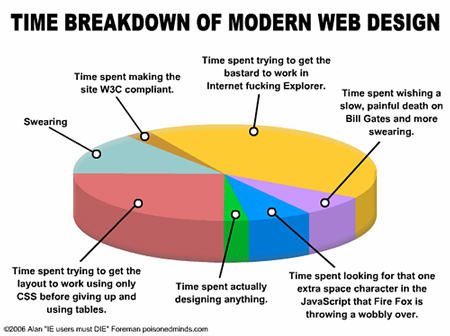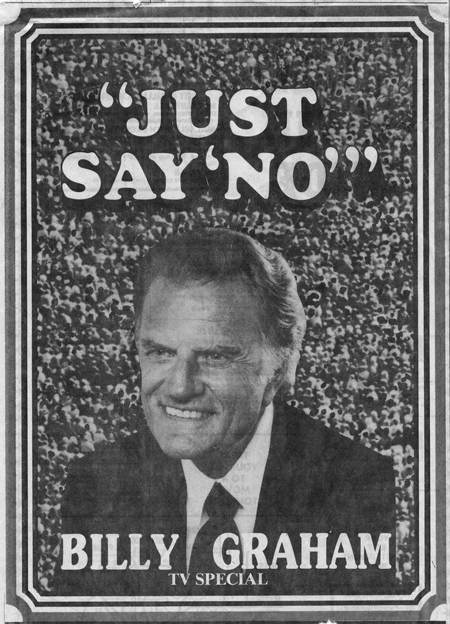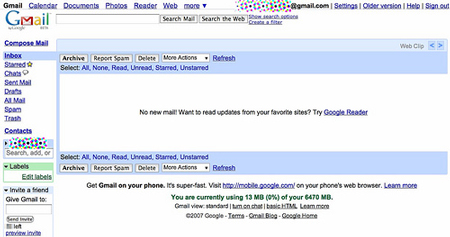
Time breakdown of modern web design, via Flickr
As a web designer working mostly on your computer, distractions are only a click away. Who has not spent his afternoon browsing stupid Youtube videos instead of creating those wireframes your client is waiting on? In this article, we will take a look at how to get away from distractions, but also how to make better use of your working time.
Key concepts to better manage your time
In order to be more productive, it is important to understand a few concepts that will help you to focus better on the right things.
Learn to say “NO”
The first thing to learn: don’t take work that you don’t have time to do properly. It will make your life harder and your clients will probably not be too happy if their project has been executed in a rush. After all, work you do not have to do is time you do not have to manage.

Just say no, a vintage ad via Dean Terry on Flickr.
Planning ahead
Much more important than you would think, planning your day or week ahead will make it easier to know what steps to take without having to think constantly. As a web designer, you have to be your own manager and give yourself orders that are easy to follow.
Be aware of how you use your time
Glancing at the clock from time to time isn’t the most efficient way to manage your time. Especially if we’re doing multiple things during the day because it’s hard to estimate exactly how much time we devote to each task. Luckily, modern SaaS software gives us a helping hand! Time tracking program logs work hours automatically, assigns them to the appropriate projects, and provides us with detailed reports on how we consume the time across various activities. Smart, easy to use and saves much of your time for things that are truly important.
Wrapping it up
The part that is the most forgotten by designers when managing their time. Take some time at the end of the day to see what you have achieved, how you managed to handle the tasks you planned. It will give you a much needed overview of what’s going on and will allow you to become better at planning.
Set priorities
Do what’s important first. Even if you are working hard, doing secondary tasks instead of your important work can also be considered as procrastinating. If you get better at setting priorities, you will for sure also know when to say “no” in the future.
Forget about multi-tasking
In the age of social media and constant online distractions, this rule has become hard to follow. Unfortunatly, your brain doesn’t have the ability to properly focus on several tasks, so you will need to give up some of that distraction to properly concentrate on your work.
Take a break
Don’t overwork yourself, it’s useless. You body needs rest to function properly, and if your body and brain aren’t well-rested you will not be productive enough. A short break to take a nap or go for a walk will tremendously help your working performances when you get back to your tasks.
Some popular time management techniques
Because the first key concepts given above are good, but they don’t tell you much about quick implementation, I’d like to give you some techniques that will help you to get started. These have all been created by people who have become excellent at managing their time, so follow their example. In my opinion, the best way to take advantage of these methods is to combine the ones that fit the best to your personality.
Inbox zero
An email management technique invented by Merlin Mann. The idea is fairly simple: bring down the emails in you inbox to zero. Said like that it can sound quite simple, but if you handle a lot of emails bringing your inbox down to zero can be quite hard. Merlin created a set of techniques and tips to help you achieve that. He looks at common problems people have with emails and analyzes the psychological barriers that prevent us from replying right away. He has a website where he centralizes the information about inbox zero, make sure not to miss the video or the articles.

A Gmail user show off his empty mailbox, via Jose C. Silva on Flickr.
The Pomodoro technique
To make it short, the Pomodoro technique consists in working in 25 minutes increments and taking breaks. Basically, you set a timer, work 25 minutes, take a short break. After four sequences of 25 minutes, take a longer break. This way you work in short span with higher focus, which allows you to be much more productive.
Of course, the Pomodoro technique is more complex than this short explanation. The inventor of this time-management technique, Francesco Cirillo, wrote an entire book to explain it in details, so you’ll have to get the book if you want to know it better.
Geting things done
Getting Things Done is an organizational method created by productivity consultant David Allen. The method helps you to break down your tasks, prioritize important work, and insists on reviewing your work week. The philosophy behind GTD is to capture everything that catches your attention to set your mind free, then set actionable steps to make each task shorter, keeping the big picture while paying attention to small details.
To better know the technique, I suggest you watch the excellent presentation David Allen made at Google, you will get an extensive overview by the creator of the method himself. If you have more time and want to go in-depth, check out the book.
Pareto analysis
The Pareto analysis has been made popular by Google, who letted its engineers work 20% of their time on a personal project. This is how Gmail was born, one of the most popular services offered by Google.
It is better known as the 80/20 rule, stating that doing 20% of the work you can generate 80% of the benefit of doing the whole job. Or that 80% of problems (80%) are produced by 20% of the causes. The Pareto analysis allows you to identify these causes and prioritize them better. It is a great way to find what to focus on at work. To learn more about this technique check out this article on MindTools.
Conclusion
As a designer, especially if you are a freelancer, time management is crucial to the successful execution of projects. Trying to overwork yourself with 15 hours workdays will not help making you more productive, it may even have the opposite effect. The above time management techniques may not be perfect for you, but once you are conscious that they exist and are willing to improve the way your work, you will probably be successful and become a more productive designer.

